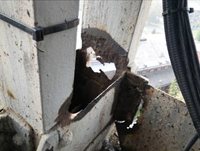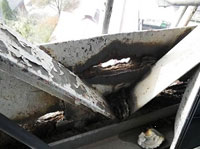Corrosion Protection
 Metals and alloys are indispensable construction materials. However, they are highly susceptible to the environmental conditions in which they are exposed. The long term result of such exposure is deterioration and damage to the original properties of the metal. This deterioration is commonly known as corrosion. Corrosion affects virtually every metal. The cost of damage caused by corrosion is estimated to be in excess of billions per year. Currently, in industrialized countries, these costs translate into financial losses equivalent to 4-5% of GDP. Financial losses are not the only consequence of corrosion, inadequate corrosion control is also responsible for the loss of lives.
Metals and alloys are indispensable construction materials. However, they are highly susceptible to the environmental conditions in which they are exposed. The long term result of such exposure is deterioration and damage to the original properties of the metal. This deterioration is commonly known as corrosion. Corrosion affects virtually every metal. The cost of damage caused by corrosion is estimated to be in excess of billions per year. Currently, in industrialized countries, these costs translate into financial losses equivalent to 4-5% of GDP. Financial losses are not the only consequence of corrosion, inadequate corrosion control is also responsible for the loss of lives.
Corrosion control offers proven, cost effective ways to reduce the premature deterioration of materials. By making a prudent investment in extending the service life of steel structures, investors not only protect themselves from exorbitant financial losses, but protect both the public and the environment in the process. Successfully doing so necessitates the application of the appropriate corrosion protection system for new structures as well as the regular maintenance and restoration of existing structures.
Corrosion surveys
Corrosion surveys are conducted to assess the current surface condition of a steel structure. The objetive of a corrosion survey is to determine the probability of corrosion and to recommend a protection coating system to counteract this risk. A corrosion survey is a prerequisite to performing any type of maintenance or renewal work on a steel structure. This survey is prepared by performing a visual assessment of the steel structure and taking key measurement readings which include paint coating thickness and integrity of adhesion.
Corrosion protection proposals
 We provide protective paint system recommendations for steel structures in accordance with the standard EN ISO 12944 - 3. The objective of this proposal is to identify the areas of a steel structure that are most vulnerable to corrosion and subsequently propose the optimal surface treatment. This requires that all aeas of the steel structure be exposed for inspection, treatment and maintenance. In particular, we perform a visual inspection for sharp edges, welding defects, water pools, unsuitable contruction materials, and poor foundation anchoring. By addressing the vulnerabilities discovered during this evaluation, further damage to the protective coating system and the steel structure itself is prevented.
We provide protective paint system recommendations for steel structures in accordance with the standard EN ISO 12944 - 3. The objective of this proposal is to identify the areas of a steel structure that are most vulnerable to corrosion and subsequently propose the optimal surface treatment. This requires that all aeas of the steel structure be exposed for inspection, treatment and maintenance. In particular, we perform a visual inspection for sharp edges, welding defects, water pools, unsuitable contruction materials, and poor foundation anchoring. By addressing the vulnerabilities discovered during this evaluation, further damage to the protective coating system and the steel structure itself is prevented.
Service life assessment of protective coating systems
 The service life of a protective coating system is the time period the system is expected to provide sufficient surface protection and aesthic appeal. Determining the the service life of a protective coating system is a fundamental aspect of designing optimal systems. Frequently, coating systems fail prematurely as a result of coating not compatible with the environment or improper application of paint coatings. The durability of a coating system depends on the design layout, properly chosen coating system for steel substrate surface conditions, atmospheric conditions, degree of mechanical, and application conditions. All of these variables must be factored into an assessment of the service life a protective coating system.
The service life of a protective coating system is the time period the system is expected to provide sufficient surface protection and aesthic appeal. Determining the the service life of a protective coating system is a fundamental aspect of designing optimal systems. Frequently, coating systems fail prematurely as a result of coating not compatible with the environment or improper application of paint coatings. The durability of a coating system depends on the design layout, properly chosen coating system for steel substrate surface conditions, atmospheric conditions, degree of mechanical, and application conditions. All of these variables must be factored into an assessment of the service life a protective coating system.
We provide coating system service life assessments for both new construction and existing structures, during maintenance, and PKO restoration. Our assessment are in accordance with applicable technical standards.
PKO Implementation Supervision
To benefit from the maximum durability of a protective coating system, it is critical to ensure that it is installed with strict adherence to manufacturer instructions and specifications. Our company provides the supervision of protective coating system installation to ensure compliance with standards, regulations, and manufacturer specifications.
- Inspection of wet film thickness in accordance with EN ISO 2808
- Non-destructive inspection of dry film thickness in accordance with EN ISO 2808
- Destructive inspection of coat thickness and defects in paint in accordance with ASTM D 4138
- Detection of shades of color paint
- Assessment of paint resistance and adhesion in accordance with EN ISO 2409, ASTM D 3359 and EN ISO 16276-2
- Assessment of paint hardness and strength in accordance with EN ISO 4624 and EN ISO 16276-1
- Testing the adhesion of electro applied coatings in accordance with ISO 2819
- Inspection of thermally sprayed coatings of Zn, Al and their alloys in accordance with EN ISO 2063
- Inspetion of zinc sprayed coatings by immersion in molten metal in accordance with EN ISO 1461
Preparation of support documentation
We provide detailed documentation for all activities carried out by our inspectors. This documentation provides development expertise, design PKO, reports of inspection activities that is supplemented with verifiable data, visual graphs, photographic evidence, and much more.

